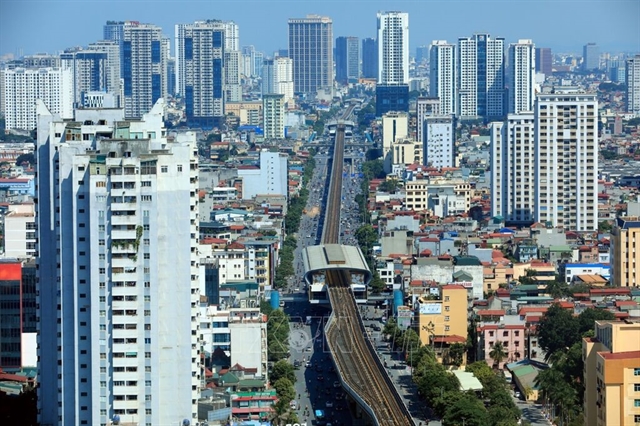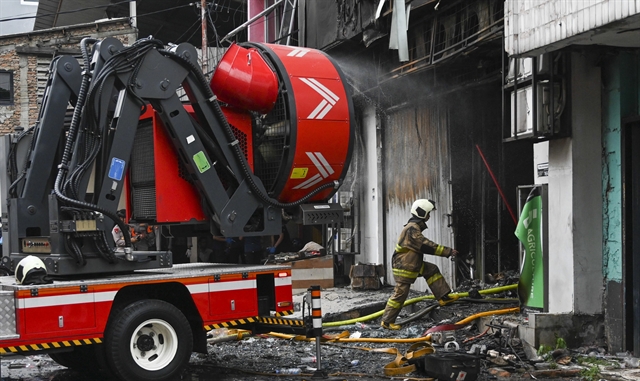 Economy
Economy

 |
| Viettel Post's warehouse in Quang Minh Industrial Zone, Hà Nội. With the boom of the e-commerce and logistics industry, investors should develop further warehouse infrastructure. — VNA/VNS Photo |
HÀ NỘI — The explosive growth of e-commerce and logistics in Việt Nam is pushing up demand for warehouse real estate along with infrastructure investment.
According to the Vietnam Industrial Real Estate Highlights 2024 report from Savills Việt Nam, the supply of ready-built factories and warehouses across the country has reached 15.1 million sq.m, rising by 31 per cent year on year, with strong growth across key localities.
The overall occupancy rate is 80 per cent, representing strong demand, with an average rent of US$4.60 per sq.m per month nationally.
The ready-built factory and warehouse supply in the Southern Economic Zone has reached 10.6 million sq.m, with factory supply accounting for 49 per cent of the share and warehouses accounting for 51 per cent. The region is 80 per cent occupied with an average rent of $4.40 per sq.m per month.
In the Northern Economic Zone, ready-built factory and warehouse supply is 4.5 million sq.m, accounting for 30 per cent of the national supply, with a distribution ratio of 61 per cent factories and 39 per cent warehouse assets.
In 2024, Việt Nam's industrial property sector is transforming, shifting towards high-value-added manufacturing and robust infrastructure investments.
The re-establishment of foreign supply chains is positioning Việt Nam as a new production hub, ushering in opportunities for industrial park (IP) development.
After weathering a challenging 2023, the sector has rebounded, attracting a new wave of electronics manufacturers and advanced industries looking to capitalise on the country's strategic position in the global supply chain.
With IP occupancy rates at record highs, developers are introducing innovative industrial property products to meet the rising demand for innovative facilities.
The Vietnamese Government continues to invest heavily in infrastructure and skilled labour development, aligning with the national objective of moving up the global value chain. These strategic efforts have positioned Việt Nam as a key player in high-tech manufacturing, driving both economic growth and industrial modernisation.
Mordor Intelligence, a research and consulting firm, points out that Việt Nam's transportation and logistics market is expected to reach $48.6 billion by 2024. With a compound annual growth rate (CAGR) of 6.8 per cent, this value is expected to reach $71.9 billion by 2030.
Meanwhile, according to the e-Conomy SEA 2024 report by Google, Temasek and Bain & Company, Việt Nam's e-commerce market is estimated to reach $22 billion this year, ranking third in Southeast Asia after Indonesia ($65 billion) and Thailand ($26 billion). This market has grown by 18 per cent compared to last year, the third-fastest growth rate after the Philippines (23 per cent) and Thailand (19 per cent).
Việt Nam is expected to maintain this growth rate with an average of about 19 per cent growth annually to reach $63 billion by 2030. By then, the country is expected to surpass Thailand, ranking second in the region after Indonesia.
Logistics has significant promise domestically as one of the fastest growing sectors globally, driven by the country's strong economy, trade, high value-added manufacturing and a growing middle class fuelling the rise of e-commerce, according to Savills Việt Nam.
With the boom of the e-commerce and logistics industry, director of industrial services at Savills Việt Nam John Campbell proposed a number of recommendations for the Government and investors to improve and expand logistics infrastructure in the years to come.
"The most significant step any government can take to facilitate logistics is to invest heavily in infrastructure and ensure that projects are completed on time and smoothly. Infrastructure is the backbone of logistics, encompassing everything from customs procedures to intermodal transport, roads and airports," he said.
"Another crucial factor is ensuring sufficient land bank for logistics and e-commerce. Some industrial parks in Việt Nam are designated for manufacturing only, which can pose challenges for logistics and e-commerce companies seeking suitable land. To address this, it's important to have industrial parks that are flexible enough to accommodate both manufacturing and logistics operations," Campbell noted.
"Many industrial parks zoned in 2007-2008 were primarily designated for manufacturing, perhaps due to a less pronounced focus on logistics and e-commerce at the time," he added. "However, the rapid growth of these sectors has highlighted the need for more diversified land use in industrial parks."
Future master plans for new industrial parks should allocate sufficient space for logistics and warehousing. Additionally, given the significant growth of e-commerce in Việt Nam, it's essential to provide suitable locations for distribution centres.
With a population of nearly 100 million people, Việt Nam has a significant online shopping market. Over 80 per cent of the population uses the internet for shopping, driving a surge in e-commerce activity.
To accommodate this growth, there is a growing need for land to develop logistics facilities. However, limited availability of suitable land can lead to increased rental costs for warehouses. — VNS




